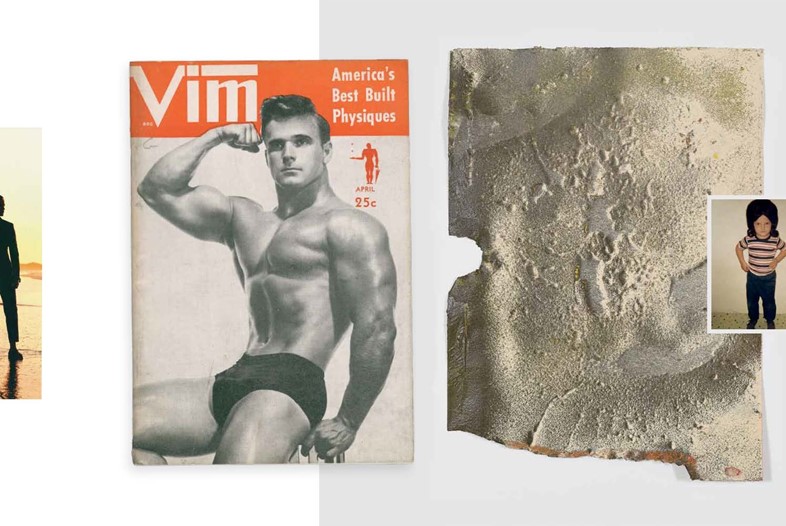A bodybuilding magazine from the 50s and 60s, Tomorrow’s Man is being given a new lease of life by artist Jack Pierson
- TextMiss Rosen
Back in the 80s and 90s, long after the sun went down, peddlers would set up an impromptu flea market with old possessions displayed on blankets set down on the sidewalks of Second Avenue in New York’s East Village. It was here, amid Puma tracksuits and fake Chanel jewels, that American artist Jack Pierson discovered Tomorrow’s Man – a men’s magazine from the 50s and 60s dedicated to bodybuilding.
A self-described “short-attention-span collector,” Pierson was instantly intrigued and headed over to Physique Memorabilia – a purveyor of vintage male erotica that required patrons to buzz the door for entrance and have a specific reason for their visit. No casual browsers were allowed.
“Between those two places I made a little collection of my own,” Pierson recalls. “They had resurfaced on my desk around the time that Robert Bywater asked me to do a book for him. His intention was for me to do a little book of my new photographs but at that moment I was feeling this kind of ephemera and magazine work I had been doing myself. I was also more interested in other artists than I was in myself.”
Inspired, Pierson proposed an idea: a brand new version of Tomorrow’s Man that combined clips from vintage physique magazines with work from contemporary artists with cutting edge design. Images were cropped, collaged, and juxtaposed in an innovative way that suggested the unexpected and evocative associations one makes when perusing a thrift shop.
Gone was the formality of the traditional art book, with its straight-laced presentation, and in its place came a refined yet unbridled bevy of art, photography, and kitsch from the past half-century. Since 2014, Pierson has created four volumes of Tomorrow’s Man (Bywater Bros. Editions), a selection of is now on view in an online exhibition on the Tom of Finland Store, until September 7, 2018.
“It was supposed to be a one-off thing but it seemed like a magazine that after the first one came out. I was like, ‘What if we kept this going? Let’s plan to do 13,’” Pierson reveals.

The number was inspired by The Yellow Book a British literary periodical that published 13 volumes between 1894 and 1897, which featured art, poetry, and prose from Aubrey Beardsley, John Singer Sargent, Henry James, H.G. Wells, and William Butler Yeats, to name just a few.
“The Yellow Book was kind of had a gay subtext, or a very effete subtext. It wasn’t explicitly but that was part of the curatorial/editorial dimension,” Pierson explains. He told the publishers, “We’ll make it like The Yellow Book for right now.”
Pierson instinct was spot on: Tomorrow’s Man has been a success since it’s first volume. “It makes its money back, which is, to me, astonishing, because most art books don’t. So we just make each issue bigger,” he says.
The exhibitions also receive similar love. “We just did one that was a big hit. It was in a side room at my own show and a couple of the newspapers chose, not my show but the Tomorrow’s Man show as the best show in LA,” Pierson laughs.

Whether curating an exhibition or designing the magazine, Pierson’s approach is driven by an eclectic yet elegant aesthetic. “When I do a show it is generally not a row of photographs all at the same level all around the room. It is like: one up in the corner, another one down, a big one here, a small one there – kind of like what I call a Family of Man installation technique. There’s nothing I love more than installing an art show, whether it is my own or a group show. I love figuring it out. It’s the same thing as the magazine; it’s design.”
This sensibility is evident throughout the family of artists included Tomorrow’s Man, which brings together works by David Carrino, Alejandro Cesarco, Pat de Groot, Peter Fend, Mark Morrisroe, Tibi Tibi Neispiel, Om from India, Richard Tinkler, John Tottenham, and Andy Warhol, among others.
Each issue inspires new ideas from Pierson, who reveals, “The fourth issue was the least homoerotic – except it comes with these four huge posters of male nudes that I took of model Miles McMillan. Just when people think this is a homo magazine full of naked guys, I’ll pull it back and make it a very dry art magazine, just to change the look.”
Pierson continues to find inspiration in the vintage magazines. “A lot of it is tongue-in-cheek,” he explains. “Not so much in Tomorrow’s Man but in those magazines in the 60s where prurience was being purveyed, they would include art. In case they got busted, they could say, ‘This is in the service of art!’ I was alluding to that by the time we got to Issue 3: ‘Look see we’re very intellectual as well – and here’s this beautiful boy on the beach.’ Some of that humor might go over people’s heads but it amuses me.”
Jack Pierson: Tomorrow’s Man Retrospective is at tomoffinlandstore.com.















